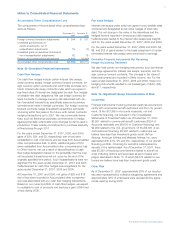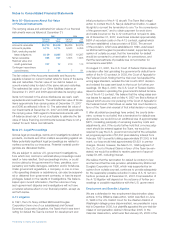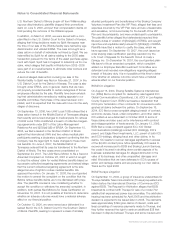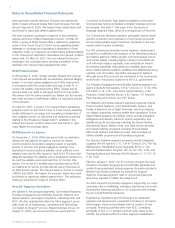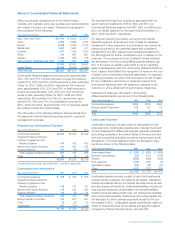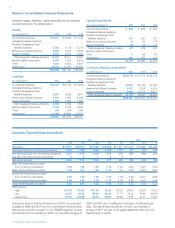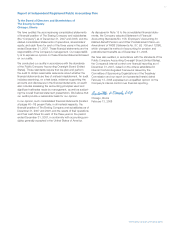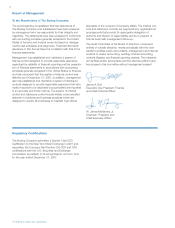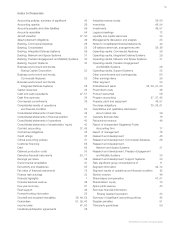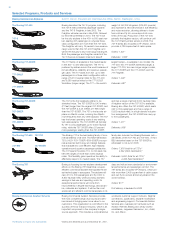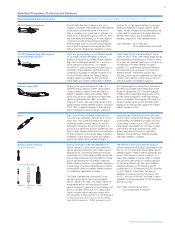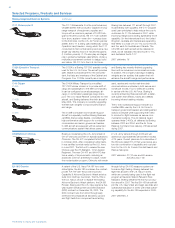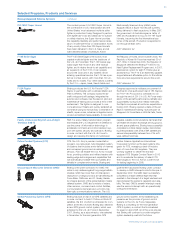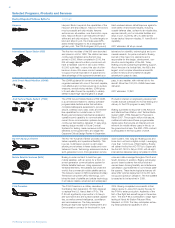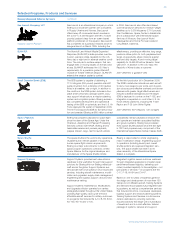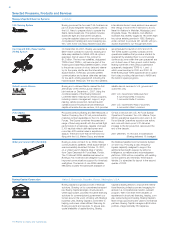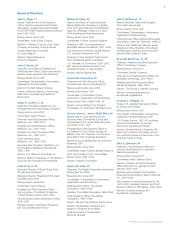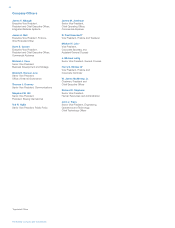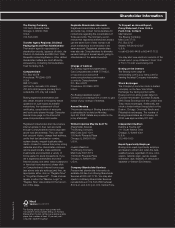Boeing 2007 Annual Report Download - page 84
Download and view the complete annual report
Please find page 84 of the 2007 Boeing annual report below. You can navigate through the pages in the report by either clicking on the pages listed below, or by using the keyword search tool below to find specific information within the annual report.
81
Selected Programs, Products and Services
Boeing Integrated Defense Systems James F. Albaugh, President and Chief Executive Officer, St. Louis, Missouri, U.S.A.
AH-64D Apache Longbow The AH-64D Apache Longbow is the most
capable, survivable, deployable and maintainable
multimission combat helicopter in the world.
After completing U.S. government multiyear con-
tracts for 501 Apache Longbows, the U.S. Army
has contracted with Boeing for 47 new Apache
Longbows and 96 remanufactured Apaches.
Boeing began work on a nonrecurring engineer-
ing contract to support upcoming Block III AH-
64D production. Boeing has delivered, is under
contract for or has been selected to produce
advanced Apaches for Egypt, Greece, Israel,
Japan, Kuwait, Singapore, the Netherlands, the
United Arab Emirates and the United Kingdom.
Several other nations are considering the
Apache Longbow for their defense forces.
2007 deliveries: 42 (17 new and
16 remanufactured, plus 9 kits)
737-700 Airborne Early Warning and
Control (AEW&C) System
Flight and ground testing of two AEW&C aircraft
for Australia’s Project Wedgetail continues.
Boeing conducted a successful mission system
flight test on Wedgetail aircraft No. 1 and func-
tional checkout of aircraft No. 2 in Seattle.
Aircraft No. 1 also participated in Trident Fury, a
Canadian military exercise. Modifications are
underway in Australia on aircraft Numbers 3–6.
The first AEW&C aircraft for Turkey’s Peace
Eagle program completed its first functional
check flight and mission system flight in Seattle.
It also made its first international flight to the
Dubai Air show. Three other Peace Eagle aircraft
are undergoing modifications in Turkey to trans-
form them into AEW&C platforms. A contract for
the Republic of Korea’s AEW&C program
received U.S. government approval. Planning
and scheduling are underway to provide four
AEW&C aircraft. The Boeing solution also
includes ground-support segments for flight and
mission crew training, mission support and air-
craft and system modification support.
Airborne Laser (ABL) Boeing is the prime contractor for ABL, a
directed-energy weapon system using speed-
of-light lethality to detect, track and destroy
ballistic missiles in their boost phase of flight,
when they are most vulnerable and before they
deploy countermeasures. ABL, a modified
Boeing 747-400F, also cues other layers of the
global ballistic missile defense system. In August
2007, ABL completed a series of flight tests in
which it tracked an airborne target, measured
and compensated for atmospheric turbulence
and fired a surrogate high-energy laser at the
target. In September 2007, the team began
installing ABL’s actual high-energy laser in the
aircraft. When integration of the high-energy
laser is completed, the program will conduct a
series of system-level ground and flight tests,
leading to an intercept test against an in-flight
ballistic missile in 2009.
Ares I Ares I is an in-line, two-stage rocket that will
carry the crew exploration vehicle Orion to low-
Earth orbit. This rocket will replace the space
shuttle as NASA’s primary vehicle for human
exploration. Boeing is the prime contractor to
produce and deliver the avionics systems for the
Ares I rocket. Boeing is also the prime contractor
for the production of the upper stage, including
installation of the avionics system and design
support for NASA. Both contracts have a
combined value of almost $2 billion and mark
the first major contracts that Boeing has earned
under NASA’s Constellation program, focused
on returning to the moon by 2020. NASA will
have design responsibility for the Ares rockets
with the first test flight scheduled for 2009.
Boeing will perform its work in Huntsville,
Alabama, and at Michoud Assembly Facility
near New Orleans, Louisiana.
Boeing Launch Services
Commercial Delta II
Commercial Delta IV
Medium Medium Heavy
Plus
Boeing continues to offer the Delta family of
launch vehicles to commercial customers with
launch services contracted with United Launch
Alliance (ULA). Commercial Delta launches are
conducted from ULA’s existing Delta launch facil-
ities at Cape Canaveral Air Force Station, Florida,
and at Vandenberg Air Force Base, California.
Delta rockets provide our commercial customers
a wide range of payload capabilities and vehicle
configuration options to reliably deliver missions
to virtually any destination in space.
The Delta II remains the “workhorse” of the
launch industry and is the most successful
launch vehicle in its class. The Delta II family of
expendable launch vehicles supports space
launch missions to geosynchronous transfer orbit
(GTO), low-Earth orbit (LEO) or to deep space.
Delta II rockets can lift payloads ranging from
891 kilograms (1,965 pounds) to 2,142 kilograms
(4,723 pounds) to GTO; and 2.7 to 6.0 metric
tons (5,934 pounds to 13,281 pounds) to LEO.
The Delta IV is the most advanced family of
rockets developed by Boeing in partnership with
the U.S. Air Force Evolved Expendable Launch
Vehicle program. Delta IV blends advanced and
proven technologies to launch medium- to
heavy-size satellites to space. Delta IV rockets
can accommodate single or multiple payloads
on the same mission and can carry satellites
weighing between 4,210 kilograms (9,285
pounds) and 13,130 kilograms (28,950 pounds)
to GTO. Delta IV rockets also can launch
satellites to polar and sun-synchronous orbit.
At LEO, the orbit of the ISS, the Delta IV has a
capability to lift approximately 23,000 kilograms
(50,000 pounds).
2007 Delta commercial launches:
3 successful Delta II missions
The Boeing Company and Subsidiaries


